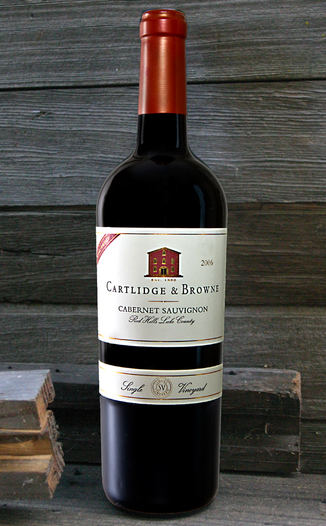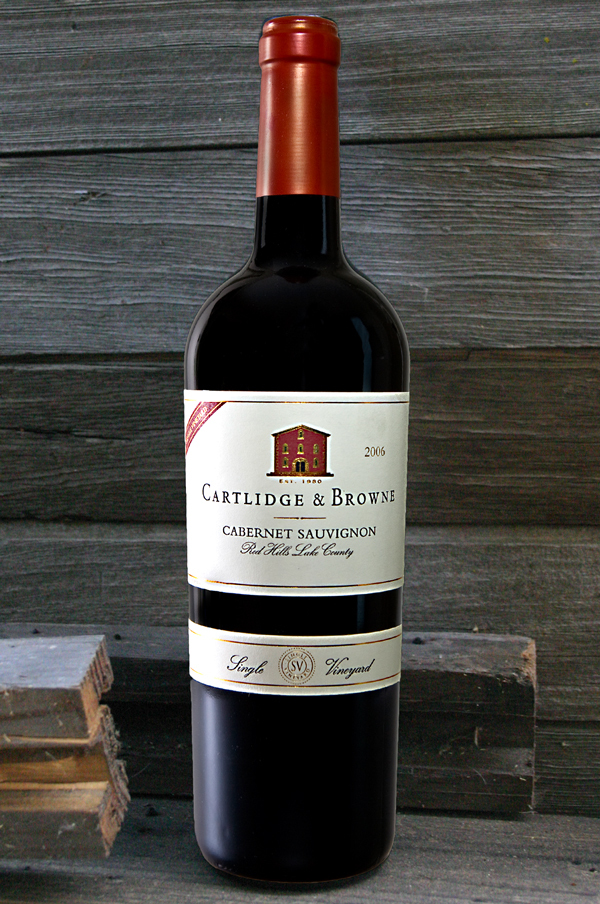What We Say 2006 Red Hills Lake County Cabernet Sauvignon
SECRET SAVINGS ALERT:
Subscribe to our Daily Dispatch (above) and you’ll always know what our Top Secret coupon code of the day is. Every day we issue a new members-only code that entitles you to have Ground Shipping included and, sometimes, an added discount!
Mission Codename: Pristine
Operative: Agent Red
Objective: Comb the volcanic hills of Lake County, in search of a fantastic Cabernet Sauvignon for our Operatives
Mission Status: Accomplished!
Current Winery: Highlands Winery
Wine Subject: 2006 Cartlidge & Browne Cabernet Sauvignon – Red Hills Lake County
Winemaker: Paul Moser
Backgrounder: Located on the east slopes of the Mayacamas mountains, the region is best known for its higher elevation, volcanic ash soil, generally cooler climate and vineyards of low yield.
Wine Spies Tasting Profile:
Look – Deep burgundy, this wine maintains deep color concentration right out to the edge of the glass. At its core, the wine shows off a deeper core of inky garnet. When swirled, the wine shows a softly springy surface that takes a while to fully settle. When it does settle, it leaves behind tightly packed clusters of skinny legs that take a moment to emerge – before the rocket down the inside of the glass
Smell – Bold and warm, with an initial rush of blackberry, blackberry bramble, tobacco leaf, slate, cedar and soft dark cherry. These are followed by subtle tomato vine, subtle oak and soft brown spices
Feel – Light-weight and soft at first, then slightly grippy as soft tannins settle in. This effect is slow, at first, then rapid – as a dark minerality sets in drying the lips and cheek
Taste -This starts off dusky and dark, with rich flavors of dark plum, smoky mixed berries, cedar, darkest chocolate and cassis, with soft spice and slate (minerals)
Finish – Starts dusky and dark, then goes smoky and sweet. Fruit flavors linger for a long interval as dark chocolate and minerals emerge, leaving the original flavors behind
Conclusion – A delightful wine that was such a great surprise to us. Boasting the cleanest air of any California county, Lake County is arguably the cleanest and most pristine wine growing regions in California. Today’s high-elevation Cabernet Sauvignon also benefits from the volcanic soils of the region – and the prowess of it’s winemaker. With a terrific mouthfeel to go along with it’s rich flavors and bold aromas, today’s wine is a fun and relaxed wine that I found to be exceptionally food-friendly. It’s acidity makes it an easy wine to pair with most foods. I also enjoyed sipping the wine on it’s own. Decant for at least 30 minutes, and be rewarded with a softer wine with broader and more well-defined flavors that are present on opening. Enjoy!
Mission Report:
What follows is a recap of our initial interview with Paul Moser. Please note that the wine that is referred to in the interview is the wine that we featured here, previously.
Yesterday I was able to catch up with Paul Moser, the winemaker and mastermind behind Cartlidge & Browne Winery.
What follows is a transcribed extract of our short but powerful conversation:
AGENT RED: Paul! Thanks for having this quick call with me. I know how busy you are. Let me start by saying that I am crazy about your wines. They are fantastic! The wine that we are featuring today is really amazing.
PAUL MOSER: Thank you, Agent Red. I am so happy that you like it. This particular wine does exactly what a Pinot Noir is supposed to do. It makes the drinker go in and find it. That’s the reward. It’s not a full-throttle, California, stand a spoon up in it wine, like many California wines.
RED: So, what sort of wine drinker is this wine for?
PAUL: Well, its not a beginner wine. For new wine drinkers, I would recommend a great Cab. Those are easy to understand, maybe even more impressive. Pinot can be harder to grasp.
RED: Especially those that are more Burgundian, like yours?
PAUL: Especially! This wine is a wine for drinkers of more experience under their belts. That’s not to say that someone new to wine would not enjoy it. They do. It’s just that this wine has a more refined sensibility than they may be used to.
RED: So, who do you make your wines for, then?
PAUL: Another deep question! I would say that I make wines that strike a balance between my own mad stylings and what I know are wine-drinker preferences. Left to my own devices, I might go off into the woods and talk to myself as I make extraordinarily odd and eccentric wines for myself.
RED: And, have you achieved a proper balance?
PAUL: What do you think, Agent Red?
RED: I think that you have. You have crafted an extraordinary wine here. We here at Wine Spies H.Q. find it to be a brilliant balance between Burgundian and Californian. Where the fruit really does shine through, it does not muscle its way in. And, where that French refinement and restraint are there, this is no subdued wine. So, yeah, I’d say that you got this one just right!
PAUL: Thank you. I appreciate that feedback. I have always striven to reconcile the best-of fruity Cali against the refined elegance of French winemaking. When people point out the layers or depth in a wine, I really think this points to one thing: A general refined sensibility and elegance. I try for these in making my wines.
RED: Again, I think that you got it just right. Tell me, how did you come to winemaking?
PAUL: That’s easy. There was one defining moment for me. I was in college at Goergetown, in Washington D.C., a kid of 18 from California. There were several ‘alternative’ classes available, and I signed up for a wine appreciation class, thinking that I’d get some free wine out of it.
RED: Something happened in that class, didn’t it?
PAUL: I’ll say. I tasted a 1959 Chateau Lynch-Bages – and I was done for! That moment, that wine, that was a game changer for me. After that, I was obsessed! I would torment my local wine shop, buying up books and all of the wine that I could afford. I was hooked.
RED: After college, you went to work for Stanford University, right?
PAUL: You guys do your homework! Yes, I actually got very lucky. At twenty-two, the job sent me to France – to Burgundy and the Loire Valley – for two years, and it was an easy job. Every spare moment outside of work was spent working at various wineries. It was there that I got my grounding.
RED: Yet you somehow also stay true to your own California roots. At least you seem to have found a great balance between the two philosophies and styles of winemaking.
PAUL: Thank you, you pay me a great compliment, then.
RED: Thanks for your time, Paul. I am sure that our Operatives will be as crazy about your wine as I am.
PAUL: Thank you, Agent Red. Enjoy!
Wine Spies Vineyard Check:
The location of Cartlidge & Browne Winery can be seen in this satellite photo.
What the Winery Says
Cartlidge & Browne Winery


Awards & Accolades:
“The question that begs to be answered is why so many producers ignore what Cartlidge and Browne does better than just about anybody else in the state—produce fruit forward, pure, varietally correct, delicious wines.” – Robert M Parker Jr.’s Wine Advocate
About This Wine:
“It’s almost an archetype: a Cabernet’s Cabernet. The density of fruit makes it very palate filling
without being too rough. Flavors of cedar, graphite, cassis, sweet tobacco, and bittersweet chocolate
are so well-knit together that it is hard to take apart. That said, chocolate cherries immediately come
to mind. It would pair beautifully with grilled and roasted red meats, as well as game and stews.” – Paul Moser, Winemaker
The vineyard – Surrounded by tall pines, this beautiful vineyard features sloped hillsides with volcanic, iron-rich red soils and is part of California’s newest and most exciting AVAs (American Viticultural Areas), Red Hills Lake County. The Mayacamas Mountains’ elevation of 2,500 feet makes an ideal location for Cabernet Sauvignon—with hot days allowing for fruit ripening and cool nights providing the balancing acidity.
Winemaking – This wine is made from fruit grown on three small, steep hillside blocks. Two blocks are planted to clone 15, while the other features clone 337. All three areas have consistently yielded intense, large-scale wine, and the 2006 vintage was no exception. Clone 337, with its blackberry cobbler character, is especially dark and intense. Clone 15 has an elegant, focused quality and provides a nice spiciness. Each clone was fermented separately. Following malolactic fermentation, both lots spent fourteen months in oak (75% American, 25% French). The wine was then carefully blended and bottled in late January 2008.
About The Winery:
Cartlidge & Browne Winery was founded in St. Helena by Tony Cartlidge and Glenn Browne. Today the three partners are Tony Cartlidge, Paul Moser and Bob Babbe. Cartlidge & Browne Winery is based in a 100,000 square-foot, state-of-the-art facility in American Canyon at the southern end of the Napa Valley. Our fruit is sourced from approximately 1000 acres of vineyards under contract throughout California.
About The Winemaker:
Winemaking for the last 25 years has been directed by Paul Moser. Paul’s stylistic preferences have been shaped by his extensive tasting of the great wines of the world during his previous occupations as sommelier and wine merchant. A Stanford graduate, who studied in France, Paul spent extensive time working in wineries in Burgundy and the Loire. As a result, Cartlidge & Browne wines, while definitely Californian in fruit, have always had a distinctly “French” or “European” styling.
Technical Analysis:
Harvest: 9/28/06
Brix: 25.7
Alcohol: 14.27% by vol.
TA: .66 g/100 ml
pH: 3.77



